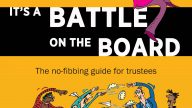Charity leaders - Try not to stress, we are all in a similar boat
Mike Findlay-Agnew shares his wellbeing tips for charity leaders.
Have you ever met a charity leader who is not under pressure? Hint – they don’t exist!
Us charity leaders tend to believe so deeply in the cause we are representing. We will work those extra hours. We will sacrifice our weekends and friends and family time. But that often comes at a cost, to ourselves.
It’s a cliché but true to say: “You need to put on your own oxygen mask before you tend to others”. I will freely admit, like most of you, that I sometimes fall into the trap of putting my own health and wellbeing second.
Here are five top tips for charity leaders to consider in terms of prioritising their own health and wellbeing:
The 80% rule
In a previous role, my CEO was great at getting tasks over the line. Her philosophy was: “If the task you are working on is 80% there, get it out the door.” When I first heard this, I felt uncomfortable. I had previously worked in a perfectionist culture where everything had to be 110%. Would this compromise my working standards? The answer to this is almost always ‘no’.
You are in your leadership role for a reason. You have proven your worth and work to a high standard already. Is spending that extra evening going over that funding proposal again, while sacrificing time with your family, really going to make the difference between securing the grant or not? Probably not. Work until you are 80% happy with what you have. Complete the task. Take the evening off.
Being selectively vulnerable
I found out about the concept of ‘selective vulnerability’ when doing a leadership course some years ago. It took me a while to realise I was already doing some of this already. I will give you an example:
During the Covid-19 lockdown period, I was managing a busy team for a charity. Two of the officers that I managed were highly stressed with their workloads while dealing with isolation (they were both living at home alone). At the same time, the CEO of the charity who I reported to was dealing with multiple work pressures. I became both an informal social worker and a rescuer to them all. I would offer to step in to pick up tasks they didn’t have time to do. I would free up time in my diary to offer them welfare checks. After a while, I was experiencing burnout. Tending to everyone else’s needs while neglecting my own. I decided to speak to them all individually about the impact it was having on me mentally and emotionally. The result? Overnight the team started to support me more directly and my work life balanced out. Selective vulnerability is not about sharing every emotion you are going through with colleagues, but it is about having your moment (hence ‘selective’ is key here) of being vulnerable with colleagues so they better understand your needs.
Gone are the days of stoic leadership – long live the selectively vulnerable leader!
Find your tribe
It’s a related point to selective vulnerability. Finding people in your network who you can talk to honestly about work-related stresses can be a game-changer. I am a big fan of LinkedIn and have used it to build my own network of other charity CEOs and leaders. You will be amazed at how willing people are to have a Zoom conversation with you on a Friday afternoon. We are all in a similar boat (although not always the same one) and you will find that talking through common concerns can make the role less isolating.
Wheel of Life
The Wheel of Life is a classic tool that is used in coaching relationships. Google it to see an example. It allows you to assess how satisfied or dissatisfied you are with all aspects of your life – for example, work life, health & fitness, finances, and relationships. Once you have used this assessment tool, you can then focus on aspects of your life that you are least satisfied with and create a plan to improve this. Taking the time to complete the Wheel of Life exercise allows you to step back from the daily hecticness of the role and really think about the life you want to live.
Invest in yourself
If you are running a busy organisation, the chances are you have invested heavily in your work colleagues. You have spent hours with them. Maybe you have supported their career development plans. Confirmed a change of work patterns to support their work-life balance. But have you invested in yourself?
Investing in yourself could be something big like taking time off with a partner to travel the world. Or investing in that creative writing course you have always wanted to do. It can also be a small investment. Finishing up on time on a Friday. Allowing yourself to have two hours out of the office to walk. Whatever it is, make sure you take the time to invest in yourself. Enhance your life and put your own health and wellbeing first.
If you want to know more come to our It’s Tough at the Top Leadership conference where I’ll be discussing prioritising your wellbeing as a charity leader. Register here today.


